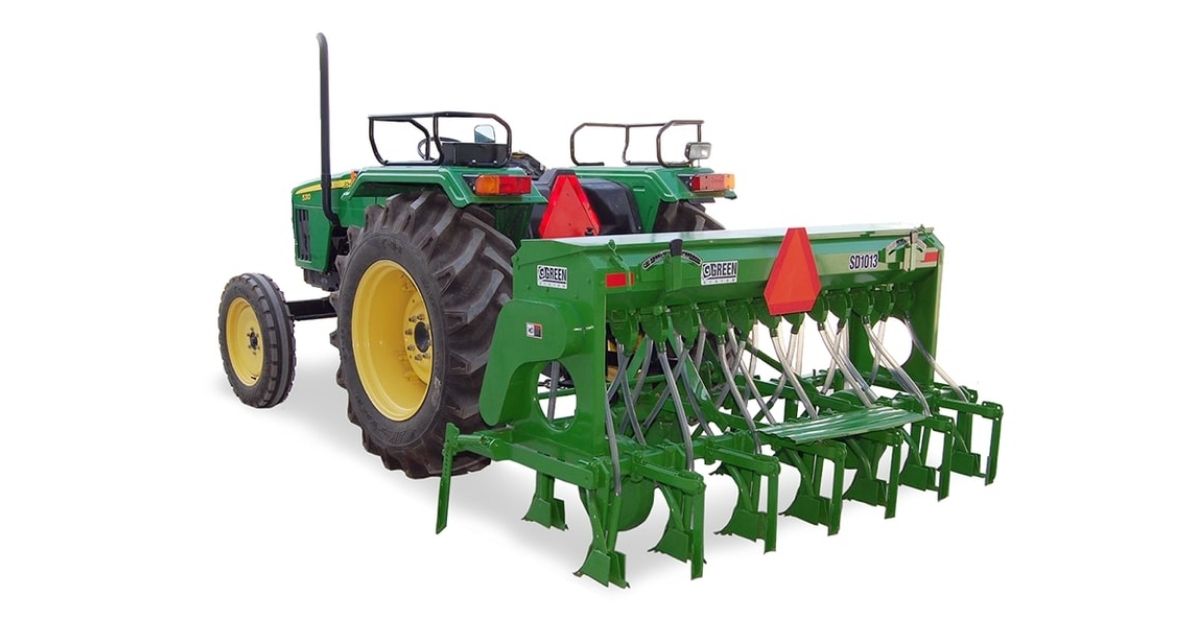A seed drill precisely plants seeds by depositing them into soil, creating trenches with furrow openers, and covering them for optimal growth.
How Does The Seed Drill Work
A seed drill is a remarkable machine that forever changed agriculture. Instead of scattering seeds by hand (which was wasteful and haphazard), seed drills deliver seeds to the soil with incredible precision. Let’s get our hands dirty and explore how seed drills function.
A Pinch of History
Before Jethro Tull invented the seed drill in 1701, farmers would broadcast seeds by tossing them across the field. Unfortunately, many seeds never took root, as birds would gobble them up, or they’d land in unsuitable spots. Tull’s invention revolutionized farming, saving seeds, improving crop yields, and greatly boosting food production.
The Mechanics of a Seed Drill
Think of a seed drill like a complex, organized funnel for your seeds. Here’s the basic breakdown of its parts and how they work together:
- Hopper: This is the tank where the seeds hang out, waiting for their big debut.
- Metering Mechanism: This clever part controls the flow of seeds, ensuring even distribution.
- Seed Tubes: Like little highways, these guide the seeds from the hopper down into the soil.
- Furrow Openers: These create small trenches or grooves in the soil – perfect little planting beds for the seeds.
- Covering Devices: These gently cover the seeds with soil, ensuring proper depth and protection.
Types of Seed Drills
Not all seed drills are created equal, folks! Here are some common types:
- Conventional Seed Drills: These typically use furrow openers with discs or blades to make those neat trenches.
- No-Till Seed Drills: Ideal for planting into undisturbed soil or crop residue, reducing erosion.
- Air Seeders: These big boys use pneumatic (air) power to move seeds through the tubes – great for covering large areas quickly.
Table of Seed Drill Components and Functions
| Component | Function |
| Hopper | Holds the seeds |
| Metering Mechanism | Controls the rate at which seeds are released |
| Seed Tubes | Transports seeds from the hopper to the furrow |
| Furrow Openers | Creates small trenches or grooves in the soil for planting the seeds |
| Covering Devices | Covers the seeds with soil after they are planted |
Benefits of Using a Seed Drill
Why would a farmer choose a seed drill over hand-broadcasting? Here’s the top perks:
- Precision Placement: Seed drills place seeds at the perfect depth and spacing, ensuring optimal growth and reducing competition between plants.
- Reduced Seed Waste: Instead of a feast for birds, way fewer seeds are wasted.
- Improved Germination: Seeds tucked safely in the soil have a better chance of germinating.
- Increased Yields: It all adds up – less waste, better germination, and optimal spacing mean seriously improved crop yields.
- Time Saver: Say goodbye to hours of hand-sowing and hello to efficiency.
Unraveling the Mystery of Seed Distribution
So, how does a seed drill ensure each seed gets its own little spot? It’s all about the metering mechanism. Let’s explore some common types:
- Fluted Roll: Think of this as a ridged roller. Seeds nestle in those grooves and are carried along as the roller turns.
- Cell Wheel: This one has little cups that grab individual seeds and deposit them precisely.
- Auger: Like a corkscrew, an auger moves seeds along a tube for even distribution.
- Pneumatic (Air): These rely on air pressure to transport and release seeds at targeted spots.
Choosing the Right Seed Drill
Picking the perfect seed drill depends on a whole bunch of factors. Consider these before you buy:
- Crop Types: What deliciousness are you growing – small grains, vegetables, or a mix? Different seed sizes and planting needs will influence drill type.
- Field Conditions: Is your soil tilled, untouched, or somewhere in between? This will guide you towards a conventional or no-till seed drill.
- Farm Size: For vast fields, large air seeders are the way to go, while smaller farms might do well with a compact conventional drill.
- Precision Needs: Do you require super-exact seed placement, or is a bit of wiggle room OK?
Additional Considerations
- Cost: Seed drills range from basic models to high-tech beasts, each with a different price tag.
- Maintenance: Some drills require more upkeep than others. Factor this into your decision.
- Versatility: Can your drill handle different seed types or planting styles?
Table: Factors influencing Seed Drill Selection
| Factor | Considerations |
| Crop Type | Seed size, planting depth required. |
| Field Conditions | Tilled, no-till, soil type. |
| Farm Size | Acreage to cover, tractor size |
| Precision Needs | Uniformity of placement, row spacing. |
| Cost and Maintenance | Purchase price, upkeep requirements, technology |
| Versatility | Ability to handle various crops and planting methods |
Beyond the Basics
We’ve covered the core of how seed drills work, but there’s still more under the hood! Modern seed drills can include cool gadgets like:
- Seed Monitors: Keep an eye on seed flow and alert you to any blockages.
- Depth Control Systems: Ensure consistent planting depth across the field.
- Variable Rate Technology: Adjust seeding rates based on soil conditions or yield maps for maximum efficiency.
Conclusion- How Does The Seed Drill Work?
The seed drill is an agricultural wonder, a testament to human ingenuity. From its early beginnings to high-tech modern marvels, this machine ensures seeds are planted with purpose. By placing seeds precisely and protecting them in the soil, the seed drill supports flourishing crops and a well-fed world. So, there you have it – that’s how the seed drill really works!
